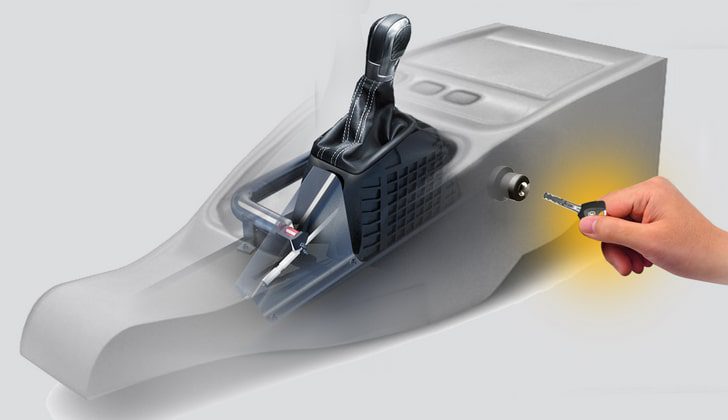
Types, device and principle of action of mechanical blockers
Content
Any driver is concerned about the safety of their vehicle. Experienced car thieves have learned to bypass even the most expensive and sophisticated electronic anti-theft systems. Therefore, motorists install additional protection - mechanical blockers, which have not lost their relevance in our digital age. Some of them are really hard to get around.
Device and types of blockers
As a rule, mechanical blockers prevent an intruder from accessing various elements of the car: doors, steering wheel, gearbox, pedals. Experts estimate such protection to be very reliable. The hijacker may simply not be ready for such an obstacle on the way.
According to the method of installation, blockers are divided into two types:
- stationary;
- removable.
Stationary ones are built into the body or mechanism of a car element. There is no way to get to them without serious dismantling. For example, a gearbox or steering column lock.
Removable bollards must be installed and removed each time. This is inconvenient and takes time. Their advantage is their affordable price.
Removable mechanical bollards
Seat lock
Quite an interesting and "creative" way - a lock on the seat. The thief got inside the car, but now he needs to get behind the wheel. But it won't work. The seat is folded as far as possible towards the steering wheel and is locked in this position with a lock. There is no way to get behind the wheel and drive a car. This protection is especially effective in three-door vehicles. In them, the seat is very tight against the steering wheel to open the passage to the rear row of seats. As a rule, such blockers are difficult to find on sale. They are made in specialized workshops to order.
Steering wheel lock
The following removable bollard is very popular with car owners. It is mounted on the steering wheel and is a metal rod with steering wheel clamps and a lock. The long side of the rod rests on the windshield or on the pedal, making it impossible to turn the steering wheel.
However, such an obstacle only seems to be reliable. The rod can be easily eaten or cut with a special tool (two-handed nippers, grinder). If the metal does not give in, then the steering wheel itself breaks out. Experienced hijackers have long learned how to deal with this kind of protection.
Steering column lock
This is a more effective protection against theft than a steering wheel lock. A special clutch with a lock is installed on the steering shaft in the area of the pedals. The wedge-shaped rod blocks rotation in either direction, resting on the pedals. The level of protection will depend on the castle larva. A good expensive lock is difficult to pick, almost impossible. Only in a rough way using tools. A weak lock is opened with a simple master key. It will take 10-15 minutes for a professional. If the master key does not help, then the entrance goes to the grinder.
Pedal lock
The principle of the pedal lock is similar to the previous versions. A bulky iron retainer with a lock is attached to two or three pedals. The hijacker has no way to squeeze any pedal and drive away. Attackers can also pick a lock or cut a part, but this will take a lot of effort.
A huge disadvantage of such protection is the inconvenience of installation. Each time you need to climb to the pedals, bend over, unfasten and fasten the protectors. The device weighs a lot. And if it's winter or mud outside, it's even worse. In some cases, only one of the pedals is blocked, for example, the clutch.
Wheel lock
A simple and "harsh" way of protection. A heavy mechanism with a lock is installed on the wheel, preferably the driving one. The wheel with it will not be able to spin. Experts call this mechanism quite effective only if the lock is made of high-quality steel and the lock has a high protection class. It is unlikely that anyone will break or saw the device in full view. At night from the work of the grinder, noise and sparks cannot be avoided. Again, the big drawback is the inconvenience of use. It is necessary to remove and install a heavy mechanism every time.
Parking brake lock
The mechanism is installed on an activated handbrake. The rear wheels no longer spin. Typically, the device is associated with a gear lever or other mechanisms for reliability. Very unreliable and easy to get around. It is enough to bite the parking brake cable under the car.
Stationary blockers
Door lock
The door is the first serious obstacle in front of an intruder. Door blockers or block locks are found in many modern cars. The device is installed even in the initial configuration of the machine. Typically, these are pins that lock onto the car body. It is controlled by a key fob or automatically after closing the door. Opening such a lock is quite difficult, but there is one caveat. A car thief can bypass it simply by breaking the glass of the car. Of course, this will raise a fuss, but in the dark it can be done unnoticed.
Checkpoint lock
This is a very effective additional protection against theft. It is a special mechanism that blocks the moving components of the gearbox. The good thing is that the blocking occurs inside. It is very difficult to open the obstacle. In special stores you can find various types of locks for checkpoints in terms of the degree of reliability.
Arc locks are considered the simplest option. They can be opened as parts of the mechanism protrude outward. But they benefit from the installation method and the low price.
The most effective are internal gearbox blockers, which are installed not from the car, but under the hood. In the cabin, only the lock slot and the pin are visible. It will be very difficult for a thief who is not familiar with the device of the gearbox and other parts of the car to get around this obstacle. But experienced attackers can. It is enough to penetrate into the engine compartment and unlock the gearbox mechanism by engaging the gear. But this cannot be done with every car.
Hood lock
To prevent the hijacker from entering the hood and getting to the ignition system, electronics or other protection components, a hood lock is installed. In tandem with the lock at the checkpoint, this will be a very serious obstacle.
Opening the hood will be very difficult, even with a crowbar. The pins are not at the edge, but much deeper. Although if you know the location of these castles, then you can get to them. You just need to cut the hood itself in certain places.
As we all know, every action has its own opposition. This is not to say that there are absolutely reliable mechanical blockers, but some of them can become a serious obstacle. The main thing is to use mechanical blockers together with a standard electronic anti-theft system. Hardly anyone will dare to steal a car with double or triple protection. Your car will be bypassed.

